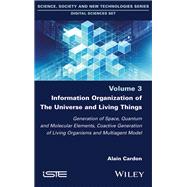
Introduction ix
Part 1. Informational Generation of the Universe 1
Chapter 1. The Computable Model, Computer Science and Physical Concepts 3
1.1. The Turning model 3
1.2. Computer science 6
1.3. Formation of the Universe in physical sciences 10
Chapter 2. The Informational Components and the Organizational Law of the Formation of Space and the Elements of the Universe 15
2.1. Informational model of universe generation and organizational law 15
2.2. The notion of generating information in the Universe 23
2.3. The generative informational component and the informational energy of the substrate of the Universe 34
2.4. The formation process of the Universe from the informational components 46
Chapter 3. An Agent Model to Represent Informational Components 53
3.1. Informational and control agents representing the components 53
3.2. The generation of atoms and molecules in the informational agent model 60
3.3. The formation of a hydrogen atom agent with informational agents 61
3.4. Formation of a helium-type atomic agent 68
Chapter 4. The Generation of the First Molecules in the Agent Approach 73
4.1. The informational characteristics of the system forming the molecules 73
4.2. Formation of simple molecules of helium hydride and dihydrogen 75
Chapter 5. The Formation of Physical Elements in the Agent Approach 81
5.1. The notion of aggregate mass 82
5.2. The formation of stars and galaxies by the general action of the organizational law 85
5.3. The informational program for the design of the universal system 94
Part 2. Life Produced by the Organizational Law 101
Introduction to Part 2 103
Chapter 6. The Characteristics of Scientific Theories of Life 105
6.1. Evolution and selection: Charles Darwin’s theory of gradual evolution and the biochemical approach 105
6.2. The constitution of life, from DNA to developmental biology 110
6.3. Genes and their expression: an open problem 113
Chapter 7. The Informational Interpretation of the Living 119
7.1. Origin of the living and bifurcation of the organizational law 120
7.2. Evolutionary reproduction 133
7.3. Informational action of reproduction of life with morphological patterns 140
7.4. The application of the organizational law in the reproduction process 148
7.5. The continuous evolution of life 155
7.6. The human species in the organizational evolution of life 161
7.7. The informational envelope of the planet Earth today 171
Conclusion 175
References 177
Index 179
The New copy of this book will include any supplemental materials advertised. Please check the title of the book to determine if it should include any access cards, study guides, lab manuals, CDs, etc.
The Used, Rental and eBook copies of this book are not guaranteed to include any supplemental materials. Typically, only the book itself is included. This is true even if the title states it includes any access cards, study guides, lab manuals, CDs, etc.